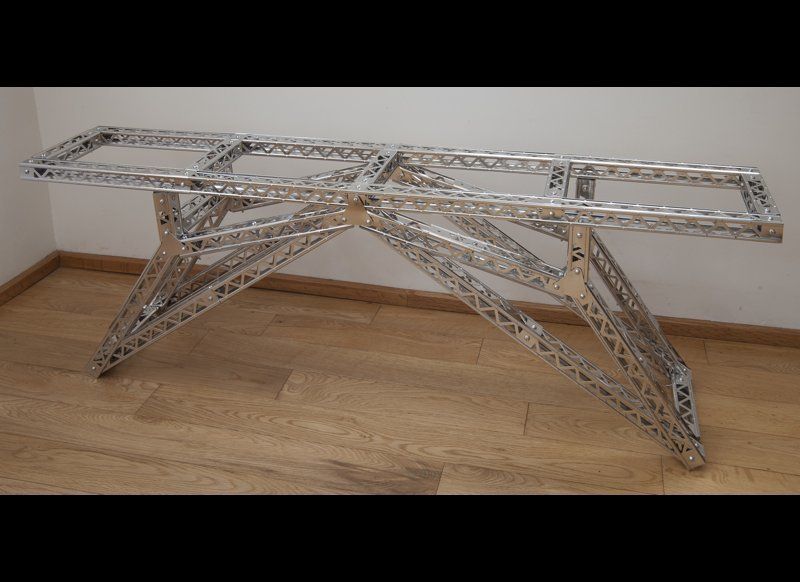The dust has begun to settle on the glory of the Getty's Pacific Standard Time. Southern California art is now canon. The pioneering artists have been named, recorded and celebrated. One of the most curious aspects of the grand exhibition was a rustle of its theatrical curtain, parting for just one silver moment to reveal the silhouette of a solitary tall man, a cowboy with his thumbs hooked into his dungarees. His name has been known only to those with access to the artist's studio or the inner sanctum of a gallery and museum. Jack Brogan is a fabricator. He creates art objects, with an expertise in a wide range of materials. His influence and his fingerprints are indelible to California art history.
Born in Tennessee in 1930, Brogan came home after serving in the Korean War. He drove a truck until the unions shut him down. Then he hauled produce. He studied engineering "here and there." His entrepreneurial drive bought him a concrete plant that would pour blocks in the morning, steam-cure them over noon and load for delivery by five. He cast custom architectural parts, invented machinery to produce concrete pipes and made the concrete pads that sit under a phone booth for Southern Bell. Debilitating neck surgery demanded that Brogan sell his interest and move to a warmer climate.
Brogan arrived in Los Angeles in 1958 where he opened a cabinet and furniture finishing shop. He built models and prototypes for Knoll. He solved production problems that the Eames brothers could not configure for Herman Miller. As real estate was developed across the Southland, Brogan was fabricating models, designing lobbies, logos and ephemera for the developers. In post-war California, the aerospace and automotive industries were leading the charge for new materials and high-tech manufacturing processes. Brogan never missed an innovation.
In the mid-sixties, Robert Irwin asked Lucius Hudson, the legendary stretcher bar maker, for help with a concept of a large silver disc. Hudson sent the artist down the block to Brogan's shop in Venice. Having a blast, Jack Brogan began to work with many artists. His knowledge of new materials and his 'can-do' creativity became an inspiration and valued resource. Brogan held many hands. The artists may have seen the Light, but Brogan knew how to create the Space. The Tennessean did not coin the term 'Finish Fetish', but everyone knew that Brogan was fetishistic about the perfection of the finish.
Is Jack Brogan an artist's assistant, a fabricator, a collaborator or an artist? The opinion depends upon whom you are talking. The rowdy artists from Venice, all surfers, daredevils and motorcycle racers, are chest-thumpers. Many times, Brogan was never invited to an opening, lest the cat leap out of the bag.
Today, Brogan is busier than ever, repairing historically significant art, fabricating new works and freely dispensing advice. I asked him, "What is your fondest accomplishment?" The answer defines the man. He replied thoughtfully, "Irwin's Prisms." Robert Irwin's original piece was four feet tall, soon growing to sixteen. To create the new height, Brogan had to devise a method to join the clear acrylic pieces and hide the seam. Mortals failed. Brogan triumphed. The connection is invisible. Most significantly, the joint proved stronger than the casting in a series of stress tests. Like a magician with a secret, Brogan smiles silently, rather than divulging the composition of his chemical creation.
Jack Brogan may have set the standard for the Pacific coast artist. The curious can learn more in a monograph, "The Art Fabrication Business of Jack Brogan" by Margaret Miya Honda (University of Delaware, 1991.) His efforts are revealed in a series of three consecutive shows at the Katherine Cone Gallery in Culver City. The showcase features the work of John Eden, De Wain Valentine, Robert Irwin, Larry Bell, Helen Pashgian, John McCracken and many more superstars. The shows are aptly titled "You Don't Know Jack."
Photographs courtesy of the Katherine Cone Gallery. This article first appeared in Artillery magazine.
------------------------
GORDY GRUNDY is a Los Angeles based artist. His visual and literary work can be found at www.GordyGrundy.com

